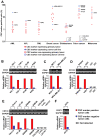Tumor cells positive and negative for the common cancer stem cell markers are capable of initiating tumor growth and generating both progenies
- PMID: 23349932
- PMCID: PMC3549952
- DOI: 10.1371/journal.pone.0054579
Tumor cells positive and negative for the common cancer stem cell markers are capable of initiating tumor growth and generating both progenies
Abstract
The cancer stem cell (CSC) model depicts that tumors are hierarchically organized and maintained by CSCs lying at the apex. CSCs have been "identified" in a variety of tumors through the tumor-forming assay, in which tumor cells distinguished by a certain cell surface marker (known as a CSC marker) were separately transplanted into immunodeficient mice. In such assays, tumor cells positive but not negative for the CSC marker (hereby defined as CSC(+) and CSC(-) cells, respectively) have the ability of tumor-forming and generating both progenies. However, here we show that CSC(+) and CSC(-) cells exhibit similar proliferation in the native states. Using a cell tracing method, we demonstrate that CSC(-) cells exhibit similar tumorigenesis and proliferation as CSC(+) cells when they were co-transplanted into immunodeficient mice. Through serial single-cell derived subline construction, we further demonstrated that CSC(+) and CSC(-) cells from CSC marker expressing tumors could invariably generate both progenies, and their characteristics are maintained among different generations irrespective of the origins (CSC(+)-derived or CSC(-)-derived). These findings demonstrate that tumorigenic cells cannot be distinguished by common CSC markers alone and we propose that cautions should be taken when using these markers independently to identify cancer stem cells due to the phenotypic plasticity of tumor cells.
Conflict of interest statement
Figures






Similar articles
-
Surface markers of cancer stem cells in solid tumors.Curr Stem Cell Res Ther. 2014 Mar;9(2):102-11. doi: 10.2174/1574888x09666131217003709. Curr Stem Cell Res Ther. 2014. PMID: 24359139 Review.
-
Identification and targeting of cancer stem cells.Bioessays. 2009 Oct;31(10):1038-49. doi: 10.1002/bies.200900058. Bioessays. 2009. PMID: 19708024 Free PMC article. Review.
-
CD166 promotes the cancer stem-like properties of primary epithelial ovarian cancer cells.BMB Rep. 2020 Dec;53(12):622-627. doi: 10.5483/BMBRep.2020.53.12.102. BMB Rep. 2020. PMID: 32843129 Free PMC article.
-
A robust culture method for maintaining tumorigenic cancer stem cells in the hepatocellular carcinoma cell line Li-7.Cancer Sci. 2019 May;110(5):1644-1652. doi: 10.1111/cas.13978. Epub 2019 Mar 12. Cancer Sci. 2019. PMID: 30784169 Free PMC article.
-
CD133+, CD166+CD44+, and CD24+CD44+ phenotypes fail to reliably identify cell populations with cancer stem cell functional features in established human colorectal cancer cell lines.Stem Cells Transl Med. 2012 Aug;1(8):592-603. doi: 10.5966/sctm.2012-0003. Epub 2012 Aug 6. Stem Cells Transl Med. 2012. PMID: 23197865 Free PMC article.
Cited by
-
The quantum of initial transformed cells potentially modulates the type of local inflammation mechanism elicited by surrounding normal epithelial tissues and systemic immune pattern for tumor arrest or progression.J Cancer. 2015 Jan 1;6(2):128-38. doi: 10.7150/jca.10787. eCollection 2015. J Cancer. 2015. PMID: 25561977 Free PMC article.
-
Cancer stem cell heterogeneity: origin and new perspectives on CSC targeting.BMB Rep. 2017 Mar;50(3):117-125. doi: 10.5483/bmbrep.2017.50.3.222. BMB Rep. 2017. PMID: 27998397 Free PMC article. Review.
-
The role of microRNAs in breast cancer stem cells.Int J Mol Sci. 2013 Jul 15;14(7):14712-23. doi: 10.3390/ijms140714712. Int J Mol Sci. 2013. PMID: 23860207 Free PMC article. Review.
-
Tumor cell stemness in gastrointestinal cancer: regulation and targeted therapy.Front Mol Biosci. 2024 Feb 22;10:1297611. doi: 10.3389/fmolb.2023.1297611. eCollection 2023. Front Mol Biosci. 2024. PMID: 38455361 Free PMC article. Review.
-
Perspectives of gene combinations in phenotype presentation.World J Stem Cells. 2013 Jul 26;5(3):61-7. doi: 10.4252/wjsc.v5.i3.61. World J Stem Cells. 2013. PMID: 23951387 Free PMC article.
References
-
- Visvader JE, Lindeman GJ (2008) Cancer stem cells in solid tumours: accumulating evidence and unresolved questions. Nat Rev Cancer 8: 755–768. - PubMed
-
- Dick JE (2009) Looking ahead in cancer stem cell research. Nat Biotechnol 27: 44–46. - PubMed
-
- Patrawala L, Calhoun T, Schneider-Broussard R, Li H, Bhatia B, et al. (2006) Highly purified CD44+ prostate cancer cells from xenograft human tumors are enriched in tumorigenic and metastatic progenitor cells. Oncogene 25: 1696–1708. - PubMed
-
- Hermann PC, Huber SL, Herrler T, Aicher A, Ellwart JW, et al. (2007) Distinct populations of cancer stem cells determine tumor growth and metastatic activity in human pancreatic cancer. Cell Stem Cell 1: 313–323. - PubMed
-
- Bao S, Wu Q, McLendon RE, Hao Y, Shi Q, et al. (2006) Glioma stem cells promote radioresistance by preferential activation of the DNA damage response. Nature 444: 756–760. - PubMed
Publication types
MeSH terms
Substances
LinkOut - more resources
Full Text Sources
Other Literature Sources
Miscellaneous

